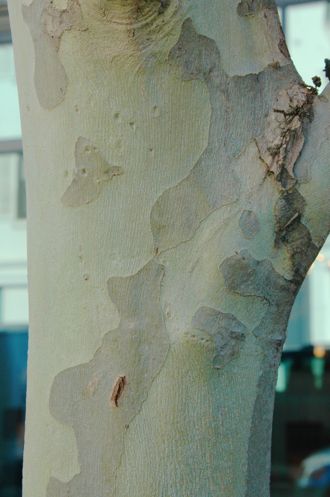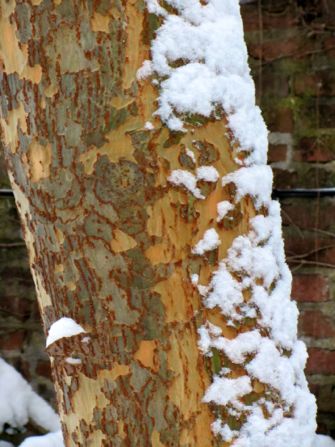Barking Up the Right Tree

Another week, another snowstorm. Probably the “latest significant snowfall in twenty years.” Probably the “last one of the season.” Will we really look back in steamy July and thinking nostalgically of twenty-degree days and icy sidewalks?
It is hard to take this lightly. Under the current layer of snow, snowdrops and crocus are blooming. Pansies planted last fall, are struggling to recover. Even primroses were sending fuchsia, orange, and yellow buds upward over the weekend.
Instead of staying indoors trying to avoid the news (are we as sick of stories about Crimea, presidential poll predictions, school closures, and missing airliners as we are of snow?), I am going to go out and shovel … and admire bark.
There are two kinds of people in this world: Those who like interesting tree bark and those that don’t even think about it, never have thought about it. And yet, there it is. Gardener designers and plant nerds think about bark, usually in the guise of “winter interest”. I am both and I love bark. Let me prove to you that I am not barking mad.

Take, for instance, the elephantine bark of a beech tree. Silvery gray, it sinuously wrinkles at branch crotches like the skin on an elephant’s knees. The beech tree on the Beech Terrace at Dumbarton Oaks is a smashing example. Beech bark, like the bark of hornbeams and deciduous magnolias, stands out beautifully against any landscape and especially in snow.
I also love the exfoliating bark of the aptly named Paper Bark maple (Acer griseum). Paper Bark maples are one of those year-around showy plants, with excellent scarlet fall color, and a winter presence that really stands out. The bark of this Chinese native ranges from a warm dark brown to cinnamon-color, and peels like crazy, all the more as it ages. It is a great tree for small gardens because it grows at a moderate pace to about 15’ wide and 25’ tall. It is best placed as a focal point in well-drained soil where it can grow without being pruned.
Oriental Plane trees (Platanus orientalis)and American sycamores (Platanus occidentalis), also have

exfoliating bark – but not until they are older. In the meantime, their bark is mottled in greens, tans, and grays, sort of like camouflage. Oriental Plane trees are native to regions from Asia Minor to the Himalayas, and are so closely related to the native American sycamore that they formed a natural hybrid known as the London Plane Tree (Platanus x. acerifolia), possibly in the mid-1600’s, that has been used all over Europe and the US as street trees. These trees grow well over 80 feet tall, have large, clumsy palm shaped leaves, and the bark reads almost as light as a white birch’s bark from a distance. I once planted several for a client in a large field near a stand of pine trees, the dark evergreen branches of which provided the perfect backdrop for the sycamores’ light colored, slightly undulating trunks. Sycamore seeds cluster in balls that hang on all winter, giving them an even more interesting winter silhouette. In the spring the balls fall, break apart, and disperse, leaving a button-like core – hence the name “Buttonwood Tree”. If you are inspired by the bark and plan to rush out to order one as soon as the streets are clear, be sure to ask for a disease-resistant cultivar like “Bloodgood” to avoid the onset of powdery mildew and anthracnose.

I also love the bark on Chinese or Lace Bark elms (Ulmus parvifolia). This tough Asian native grows quickly, especially in ideal soil conditions, and will reach a height and breadth of 40-60 feet. It has a dense but delicate branching structure, and small leaves that turn a basic yellow in fall. It also has fabulous bark. Starting out mottled gray-green, as the tree ages, the bark becomes tan and sheds in strips. Over time, the mottled bark becomes more colorful, ranging from olive green to tan to orange and beige. These elms are pollution and bad-soil tolerant, as well as generally disease resistant, so my only caution is that it is best planted on a lawn where the perpetual drop of “stuff” is not noticeable. Chinese elms drop tiny flowers in summer, their fine leaves in fall, and seeds in winter and spring, all of which clog gutters and water features, and require frequent clean up on walks and in garden beds.

I realize that not everyone is as entertained by wrinkled crotches, exfoliation, and mottling (all of which in trees are preferable and in us – not at all).
There is one tree, however, that has gorgeous bark without these characteristics and is utterly irresistible. That is the Coral Bark maple (Acer palmatum “Sango-kaku”). Like many Japanese maples, the Coral Bark maple has a delicate growing habit, usually growing slowly to 10-25 feet, with small, perfectly shaped ferny leaves that color to yellow, red-purple, and bronze in fall. It’s most striking feature, however is its startling scarlet bark which is a show stopper in a winter garden -- all the more so when the tree is surrounded by a blanket of snow. This tree is perfect for small gardens, especially if placed where it can be seen easily during the winter time, by a walk or near a much used window or entrance.
Instead of sulking indoors until the snow melts again I encourage my readers to march out and look for trees with interesting bark. I won’t make any puns about my bite, but you will definitely see I am not barking up the wrong tree!
